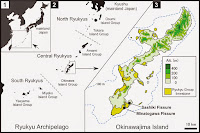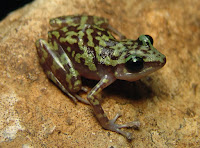Small Grass Frogs are
found across Cuba. Until 2012 these were all placed within a single
species, Eleutherodactylus varleyi, but it was
subsequently shown that many populations across the southeast of the
island belonged to a second, cryptic species, Eleutherodactylus
feichtingeri, which resembles
Eleutherodactylus
varleyi in appearance
but which has a different call, and which subsequently shown to be
genetically distinctive. Such cryptic species have profound
implications for conservation, as apparent healthy species, with
large populations and wide distributions can be shown to be groups of
less widely distributed species, each with smaller, localized
populations and different conservation needs.
In
a paper published in the journal Solenodon in February 2015, Luis Díaz
of the Museo Nacional de Historia Natural de Cuba and Blair Hedges of
the Department of Biology at Pennsylvania State University describe a
new species of Grass Frog from Pine Forests in the Humboldt National
Park in Guantánamo Province in southeast Cuba.
The
new species is named Eleutherodactylus
beguei,
in honour of Gerardo Begué Quiala, an expert on the biodiversity of
the Humboldt National Park. As with Eleutherodactylus
feichtingeri this
species was initially detected due to its distinctive call, then
demonstrated to be a separate species by genetic analysis.
Eleutherodactylus
beguei is
smaller than the two previously described species with males reaching
only 12.3-14.2 mm in length, compared to a maximum of 17.4 mm for
Eleutherodactylus
feichtingeri and
a maximum of 18.5 mm for Eleutherodactylus
varleyi.
Only a singe female Eleutherodactylus
beguei,
was discovered, this was 15.2 mm in length, and mated with one of the
males and produced a clutch of 10 ivory white eggs, 3.5-3.7 mm in
diameter. Surprisingly this is a larger clutch size than recorded in
either of the other two Grass Frog species, despite the smaller size
of the adults, with 3-4 eggs more typical. The female also called
prior to laying her eggs, which is unusual in Frogs, but which has
been recorded in members of the genus Eleutherodactylus
before.
Eleutherodactylus
beguei,
male specimen perching on horizontal leaf from which it was calling.
Díaz and Hedges (2015).
See
also...
 Cryptic diversity in West African Torrent Frogs. The West African Torrent Frog, Odontobatrachus natator,
is found in fast moving streams and waterways in the forests of Guinea, Sierra
Leone Liberia, and western Côte d’Ivoire, part of the Upper Guinean...
Cryptic diversity in West African Torrent Frogs. The West African Torrent Frog, Odontobatrachus natator,
is found in fast moving streams and waterways in the forests of Guinea, Sierra
Leone Liberia, and western Côte d’Ivoire, part of the Upper Guinean...
Robber Frogs of the genus Eleutherodactylus are found from Texas
to Guatemala and Belize and across the islands of the Caribbean. The genus was
formerly the most specious of any genus of Vertebrate Animals (i.e. it contained
more species than any other Vertebrate...
 The enigmatic Pleistocene Amphibians of Okinawa Island. In
the late 1960s and early 1970s a series of anthropological excavations
were carried out at Minatogawa Fissure on southern Okinawa Island,
producing a number of Late Pleistocene Human...
The enigmatic Pleistocene Amphibians of Okinawa Island. In
the late 1960s and early 1970s a series of anthropological excavations
were carried out at Minatogawa Fissure on southern Okinawa Island,
producing a number of Late Pleistocene Human...
Follow Sciency Thoughts on
Facebook.


